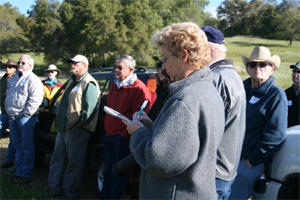Posts Tagged: rangeland
Media look to agriculture for global warming relief
As protests at the Copenhagen "climate summit" heat up and talks reach a critical stage, the media are looking at a variety of ways humans can slow carbon emissions into the atmosphere, such as changing the way we farm.
In an Ask Pablo column on a Web site called Treehugger, writer Pablo Paster considers whether people should go back to using horses instead of tractors to farm. At first glance, I thought the piece was meant to be humorous, but in fact, Paster researched whether such a change would reduce greenhouse gas emissions.
Among the data Paster used to support the idea was a 2008 UC Davis Cooperative Extension cost study on wheat production. The columnist noted that UC scientists determined it takes 5.43 gallons of fossil fuels per acre to produce 3.25 tons of wheat.
"When combusted this fuel turns into 122 pounds of carbon dioxide (CO2). Although this number is not going to be the same for every crop we can assume that it is within the right range for all grain crops," Paster wrote.
Combining this information with other data he collected, Paster concluded that tractors emit 122 pounds of CO2 per acre compared to the 21.5 pounds of indirect emissions from the horse. "If the horse feed were also cultivated by horses this number would be even smaller," Paster wrote.
He acknowledged the difficulty of producing all the world's food using horses, but said small-scale, organic farms could find many advantages to using draft horses.
"Horses have a lower upfront cost and their fuel (feed) also costs less, they tread lightly on the ground, and they even bring their own fertilizer to the fields," he wrote.
Meanwhile, National Public Radio reporter Christopher Joyce joined UC Berkeley environmental science professor Whendee Silver on a visit to a Marin County research site where she is looking at the use of compost on rangeland to increase its carbon-holding capacity.
The compost, a mix of plant clippings and animal manure, "increases plant growth, it actually also lowers the temperature a little bit, so the soil doesn't get quite as hot, it doesn't stimulate as much microbial activity."
The taller grass and minimized soil activity mean the acreage stores more carbon.
"Hopefully, (farmers will) be able to participate in a carbon market, where we can quantify how much carbon is being stored on the land, and they can sell that as a carbon offset," Silver told the reporter.
UCCE farm advisor explains rangeland irony
Forage monitoring at the UC Sierra Research and Extension Center in Browns Valley shows the land produced, on average, 2,984 pounds of vegetation per acre, 93.4 percent of normal, according to an article published today in Capital Press. That may sound fantastic - 93.4 percent looks like an A to me. But UCCE farm advisor Larry Forero said that the growth came too late for most ranchers.
In fact, in nearby Tehama County, officials are seeking a federal disaster declaration because of drought damage to its rangelands. Reporter Tim Hearden wrote that neighboring counties may follow suit.
The problem may not be too little rain, but the timing of the rain. Much of the vegetation grew after April and May storms, Forero said. By that time, some ranchers - concerned about the lack of forage on the foothill land - had already moved their cattle to higher-elevation summer pastures or to irrigated pastures.
The fact that vegetation was left behind may prove helpful in the fall when cattle return to the range. But Northern California ranchers took another blow when it rained in early June.
This late rain can sometimes do more harm than good, Forero told the reporter. When the grass is dry, rain can leach it and reduce its nutritional value.
"This is an incredibly complicated business," Forero told me when we spoke this morning.

Forage was below average each month of '09 season.
Reporters descend on San Joaquin Experimental Range
On Friday, two reporters joined ranchers and UC, Fresno State and US Forest Service academics at the San Joaquin Experimental Range for a field day, presentations and barbecue marking the centennial of the Forest Service's research program. At the event, officials signed a new memorandum of understanding outlining the research goals and administrative arrangements for the 4,500-acre facility.
As part of the agreement, UC Cooperative Extension farm advisor and county director for Madera County, Neil McDougald, takes on the role of site manager for the sprawling oak woodland research facility 26 miles north of Fresno.
Dennis Pollock, a freelance reporter for AgAlert, took a guided tour of riparian areas on the station, and Ramona Frances, the ag reporter for the Madera Tribune, visited anthropological sites. The facility was inhabited by Native Americans in the distant past, evidenced by mortar cups ground into bedrock and a faint red pictograph on a rock outcropping. Remants of the station's gold mining history include tunnels dug into hillsides, piles of tailings indicative of placer mining and long-abandoned arastras, circular rock structures used by miners to break up gold ore.
In the photo, Frances (foreground) takes notes during one of the anthropological presentations, while McDougald (red jacket) listens.

San Joaquin Experimental Range

